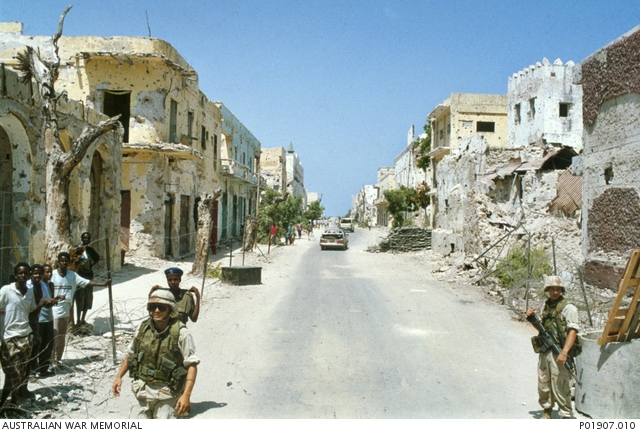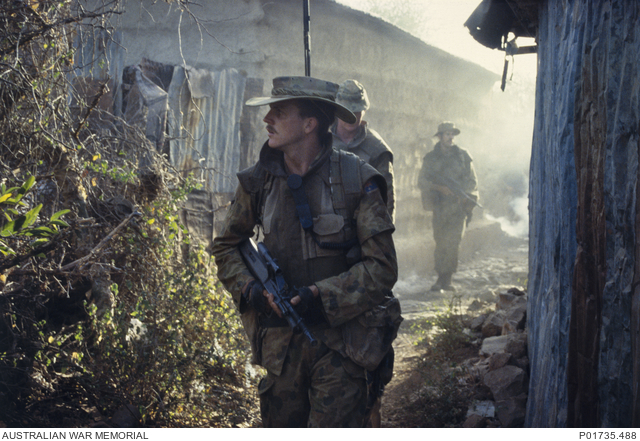'It’s made me into the man that I am today'
Advisory/warning: the following story contains distressing
content and graphic descriptions.
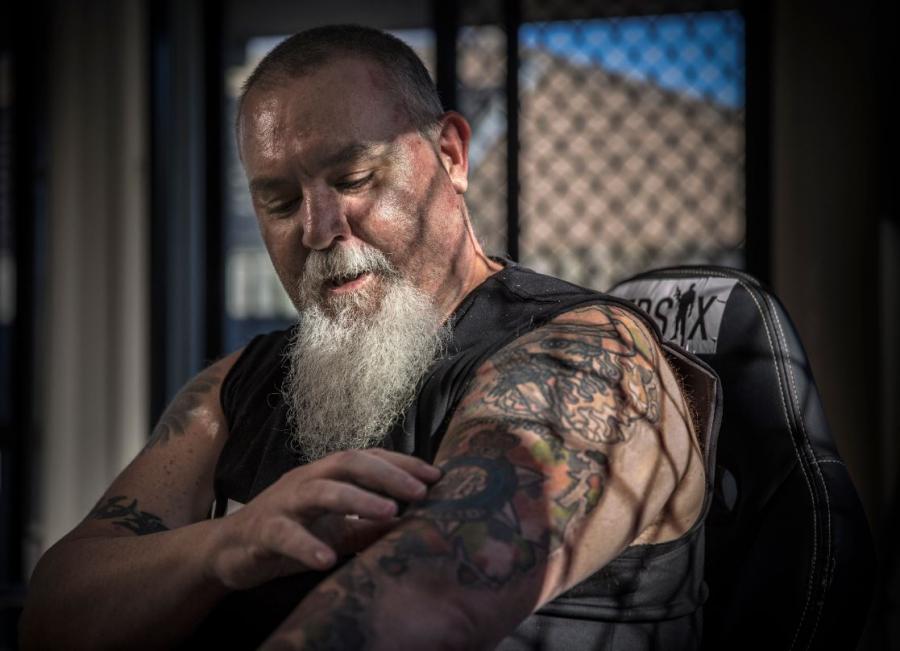
Damian Smart was 19 years old when he landed in Mogadishu.
It was January 1993 and Somalia had been mired in conflict since warlords toppled military dictator Mohamed Siad Barre two years earlier. The country had been brought to its knees, collapsing into clan warfare and then civil war. Hundreds of thousands of people died of starvation, and the country descended into anarchy, effectively ceasing to function as an organised nation state, gripped by famine.
The boy from Mackay in North Queensland had never seen anything like it.
“As soon as the ship docked, the smell was just unbelievable. It was all open sewers … and people had starved to death, and they were just left on the side of the road like kangaroos.
“For a 19-year old-guy who’d never seen a dead body in his life, to drive off a ship and probably see, 30 to 40 dead bodies in the first 20 to 30 kilometres; I didn’t get much sleep that first night, put it that way.”
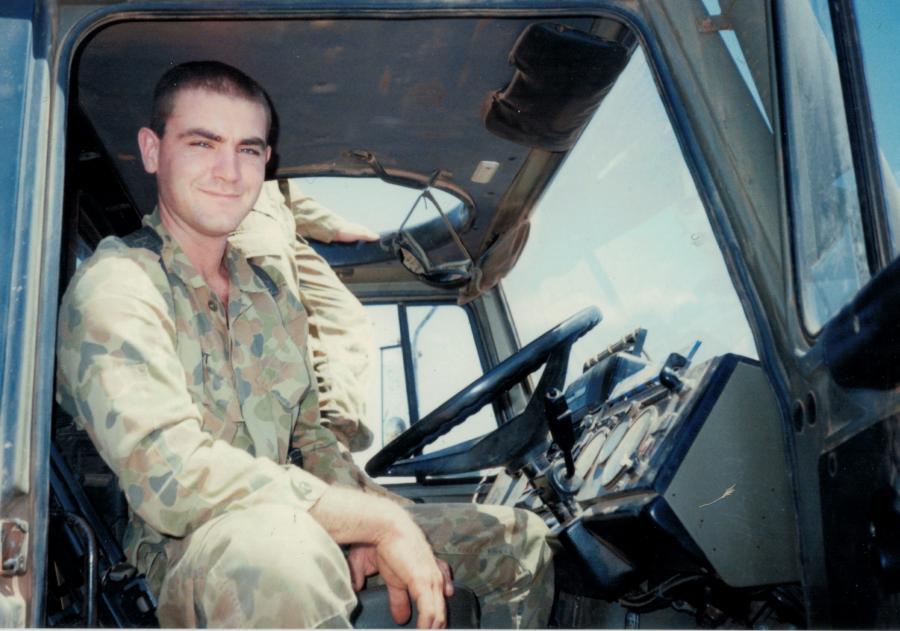
Damian Smart in Somalia. Photo: Courtesy Damian Smart
Damian had sailed into Mogadishu harbour on board the heavy landing ship HMAS Tobruk as part of Operation Solace, the Australian Defence Force’s contribution to the UN-backed, US-led multinational force, Unified Task Force (UNITAF). Codenamed Operation Restore Hope, UNITAF was charged with securing humanitarian relief operations in Somalia and protecting the distribution of humanitarian aid.
“We got to Mogadishu harbour and we started taking the lashings off our trucks and HMAS Tobruk came under fire from what they used to call a ‘technical’. It was like a Toyota ute with a 50-calibre gun hanging off the side of it and they started to open fire at us straight away.
“We heard these things – ‘ting, ting, ting’ – hitting the boat, and it sounded like someone was throwing rocks at a window … I thought, ‘That’s a bit weird. What’s going on here?’ and then the siren went off and it was all-hands to …
“It was a real baptism by fire, and we thought, holy s*** what have we got ourselves into here.”
Soldiers patrolling a street lined with damaged buildings. Somalis look on from behind a wire fence in front of the buildings. The soldiers are serving with the Australian contingent to the Unified Task Force in Somalia (UNITAF).
Damian was one of more than 1,500 Australians who deployed to Somalia between 1992 and 1995, and one of more than 900 who served in the 1 RAR Battalion Group in Baidoa as part of Operation Solace in 1992-93, Australia's largest overseas deployment since Vietnam.
He had joined the army in June 1989 and was serving with 9 Transport Squadron in Townsville when he left for Somalia on Christmas Eve 1992.
“I virtually came straight out of school and joined the army,” he said. “I always knew I would … All of my family, everyone served. Grandfathers, uncles, they had all been in the army … so ever since I was knee high to a grasshopper I wanted to join the army … It was just like a natural progression for me … That was all I was ever going to do, and as soon as I was old enough, as soon I hit the age, 16 and half, 17, I went to Townsville and signed up … I went to Kapooka ... and it was tough. I won’t mince words … It was a real culture shock, but I tell you what, I loved it.”
Somalia, 1993. A soldier stands inside the walls of the damaged and roofless Mogadishu Cathedral. Photo: Gary Ramage
He was at home when he found out he was going to Somalia.
“I was asleep in bed and I got a knock on the door from one of my mates,” he said. “We were on Christmas stand down, and there were no mobile phones in those days. He said, ‘Get your gear on, come back in to the base, we’re going to Somalia!’ I’m like, ‘Yeah, right.’ So I kind of slammed the door in his face – go away, leave me alone – and he started banging on the door again: ‘No, no, I’m serious, get your uniform on; you’ve got to see the CO [commanding officer] in 20 minutes.’ And that’s how I found out I was going to Somalia.
“We got that day to go home and say goodbye, and within three or four days we were gone...
“I’d never even heard of Somalia … so all the atlases came out, and we were like, ‘Where is this place?’ And then you find out it’s the Horn of Africa, and you go, ‘Holy hell! What’s going on over there?’”
Crew of HMAS Tobruk unloading supplies at the wharf. On the right Somalis are loading sacks of flour and grain into a truck for distribution to starving Somalis.
Baidoa, Somalia, 1993. An army truck of 1st Battalion, The Royal Australian Regiment (1RAR), passing through the vehicle convoy check point.
Buurhakaba, Somalia, 1993. Members of the 1st Battalion, The Royal Australian Regiment (1RAR), serving with the Australian contingent to the Unified Task Force in Somalia (UNITAF), supervise the distribution of grain from trucks to Somali women.
The bulk of the Australians were based at Baidoa, known as Somalia’s “City of Death”, about two hours inland from Mogadishu.
“We were at the old Somalian air force base in Baidoa.
“We did long-range patrols with the infantry soldiers up to the Ethiopian border and back, but 80 per cent of our work was convoy protection … protecting the food that was going to the villagers.
“Some places were only 70 or 80 kilometres away, but because of the roads and the landmines … it could take you 12 hours to get there while the engineers tried to clear the roads in front of us.
“It was a shock … just to see the amount of death. There was death and destruction everywhere, and it was like the whole country had been levelled.
“There’s no running water. There’s no electricity. There’s no sewerage. There’s no nothing like that. And some of the smells, and the sights you are seeing, it was just unthinkable.
“You couldn’t put a word to it. It’s just horrible. It’s famine. It’s death. And it’s just a real messed up place.
“We were always coming under fire, sometimes two or three times a food run. The bandits had been taking full advantage of the food runs, and they would stick the convoys up and steal the food and put it into big warehouses in Somalia. They’d steal everything from the aid agencies and sell it all on the black market and that’s how these warlords made their money … It was quite a lucrative business for them, and when we came along and started protecting the convoys they got pretty pissed.”
Buurhakaba, Somalia. 1993. The Australian secure area in Buur Hakaba. A number of soldiers and a dog are in the background with two trucks and an armoured personnel carrier on a dirt road in the foreground.
Elevated view of the transport area of the Australian Base. Constructed on the outskirts of town the base includes repair and maintenance facilities for the trucks, landrovers and M113 Armoured Personnel Carriers that accompanied the Australian Army contribution to the United Nations Unified Task Force (UNTAF) in Somalia.
When asked if he was frightened, he doesn’t hesitate.
“Oh, yeah, every day,” he said. “You’re always on high alert … 12, 14, 16, 18 hours a day, and it wears you down real quick. When you get back into base, it’s like, oh, I can breathe again, and then you’d have to go and do observation post pickets … so we lived on bugger all sleep while we were over there… you might only get two or three hours sleep a night… but it was a pretty big role, so we took it very seriously.
“One place is ingrained in my head. I’ll never forget it. It’s called Wajid. It was just an absolute place of death. It was so far away from anything, and so remote, that getting to them was really hard …
“The villagers were just trying to survive. They didn’t care about religion. They didn’t care about wars. They didn’t care about anything else. All they wanted to do was survive.
“They lived so far away from everything, and they couldn’t grow anything because of the drought conditions, so we were their only hope.”

Photo: Courtesy Damian Smart

Photo: Courtesy Damian Smart
He remembers the smiles on the children’s faces in Baidoa as they played with water balloons.
“These kids had never seen anything like balloons before in their lives,” he said. “They hadn’t even seen balls or anything, and here we are throwing water bombs at them, and they’re throwing water bombs back at us …
“I’ve got a photo of a little kid holding a white balloon that looks like a crystal ball because of the way the sun is shining on it, and that was a pretty powerful photo. The way they looked at it… it was like it was something from outer space or something … they’d never seen anything like it.
“We took a whole heap out on the road with us, and just blew them up and put air in them, and gave them to the kids – you wouldn’t want to waste water out there – so instead of getting swamped for food, we were getting swamped for balloons. It was good to see an actual smile on their face for once …
“Seeing those poor kids out there… that was one of the biggest things for me.
“Life over there is very cheap – it comes and it goes, and death is just part of life… the dead bodies and the rotting corpses… they were battling to keep themselves alive, let alone bury all the people who were dying … so wherever they fell is where they were left …
“The smell is something that will never leave me, and to this day, I still can’t go into butcher shops, or stuff like that. You walk into a supermarket and all I smell is blood … I just can’t do it. Even smelling a dead roo on the side of the road – bang! You’re back there, and it takes you five minutes to snap yourself out of it.”
Somalia, 1993: A soldier with supplies for food distribution to the village of Sahmandeera.
Somalia, 1993: Members of 1RAR and a United States convoy of troops and transports en route from the port of Mogadishu to Baidoa. A continuous air cover was maintained by US helicopters. The journey took approximately 10 hours in 40C heat. Although there was a continual threat of snipers, the convoy was incident free.
He feared for his life driving through the capital Mogadishu.
“I was completely s***-scared of Mogadishu,” he said. “Every time we had to go down there, we were very, very on edge because you never knew what was going to happen.
“It was an absolute powder keg, and these blokes know the lay of the land. They know every nook and cranny in the city, and I tell you what, there are lots of nooks and crannies in Mogadishu.
“Our wash point was on the other side, and we had to actually go through the Bakaara Markets and Mogadishu town, the city itself, to get to where we washed our trucks … that’s where all the fighting took place and where the battle of Mogadishu happened, and we had to drive through that every day …
“You were just on tenterhooks… and every morning we’d drive our trucks straight through there thinking: ‘Oh god, what’s going to happen to us today,’ but we were lucky.”
The courtyard and entrance to Anzac House or 'Hard Rock Cafe', in Mogadishu, Somalia. To the left an unidentified United Nations (UN) peacekeeper is seated at a table in a sandbagged area. A substantial sand bagged bunker has been constructed in front of the building on which a kangaroo and kiwi have been painted. Photo: Gary Wilson
He had mixed feelings when he found out he was coming home. He wanted to stay to help the people of Somalia, but he was also relieved.
“It was great,” he said. “I couldn’t wait to get on the plane. We’d seen enough death. We’d seen enough people dying. We’d seen enough people discarded on the side of the road.
“And that was one of the biggest things that hit me about the whole deployment. One minute you’re in a combat zone – a war zone – and you’re on the streets of Mogadishu doing patrols with the infantry guys … 17 hours later I’m at home in Townsville with my wife in a unit and that was it, that was our welcome home … It was like nothing had ever happened. You just went back and just melted back into normal army life again. But it wasn’t normal at all.
“My wife knew, from the day I got back, that I’d changed. I didn’t. In my head, I was still the same person.
Baidoa, Somalia, 1993. Soldiers on a foot patrol in a street of the town.
Baidoa, Somalia, 1993. Soldiers keeping in order a crowd of Somalis waiting at a well to be issued with water.
“When we came back from Somalia, PTSD was unheard of. We’d heard of flash backs and nightmares and night terrors, but nobody had heard of this animal called PTSD …
“It was still called shell-shock and all that kind of stuff and we didn’t get shelled or bombed or anything so we didn’t know what was going on in our heads.
“It took me 20 years to go and get the help that I needed because to me everything was normal. I’d been doing it so long it was all ingrained in my head. To me I was fine …
“But it’s just amazing what PTSD can do to a man’s psyche. It’s a horrible, horrible disease, and I call it a disease, because that’s what it is … it eats you away from the inside if you don’t get any help and it gradually creeps up on you as you get older.
“You think you are so desensitised to it once you leave, but it catches up with you in the night, and that’s when it catches up with you.
“People see the shiny medal on your chest, but they don’t understand what actually comes with it, that shiny little thing on your chest …
“My wife said I’d completely changed, and that she had lost the person that went away when I left, and got a new one back …”

Today, Damian has a map of Somalia tattooed on his arm, a permanent reminder of his experiences. His story is told at the Australian War Memorial in Ink in the Lines, a special temporary exhibition sharing stories of Australia’s military veterans, through their tattoos.
The exhibition is the first of its kind at the Memorial, featuring personal stories from men and women who have served with the Army, Air Force and Navy in conflicts and peacekeeping operations from Iraq and Afghanistan to Rwanda and Somalia.
For Damian, getting his tattoo was part of the healing process.
“I wanted it to be a reflection, not of the bad stuff, but of the good that came out of it, and how it affected me as a person,” he said.
“I had a medal in a drawer that had never been opened … and I thought, I really haven’t acknowledged my service.
“It was just sitting in the back of a drawer, and I hadn’t worn it since I got out of the army. This is 20 years on, and I thought, ‘Bugger it. I want to tell more people about it.’
“I needed something that was not going to be just another run-of-the-mill tattoo … The tattoo was a daily reminder to me to put one step in front of the other, and [that] everything’s alright.”
He never dreamt his story would one day be told at the Memorial.
“I’m very, very humbled to be a part of it,” he said.
“The Memorial to me; it means everything … It was actually life-changing for me, going down to the Memorial and seeing the stories of what happened to other people, and trying to see where you fit in to that storytelling.”
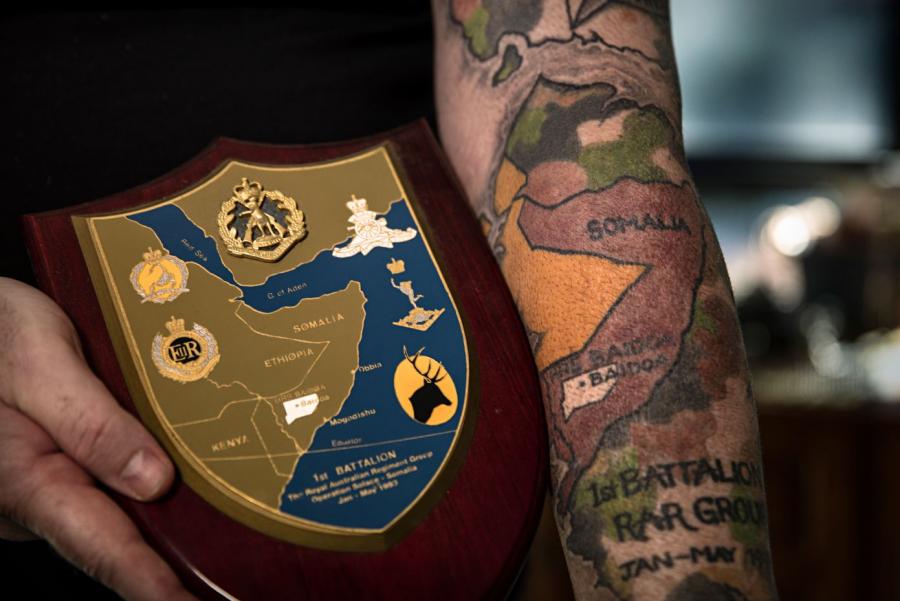
Today, he is proud of his service in Somalia and is proud to wear it tattooed on his sleeve.
“It’s an open wound and always will be,” he said. “I’m always going to bleed army. It’ll always be a big part of my life, a massive part of my life, and that’s what I wanted, I just wanted it to look like someone had just ripped the skin off and that’s what was underneath.
“You don’t realise how much six months can steer the rest of your life … and it’s a reminder to me to make sure that I tell the story of Somalia to whoever wants to listen to it …
“We just wanted the recognition of what we did, what we saw, and what we had to go through … We didn’t want big fanfares and lots of space … We just wanted to be recognised and have somewhere where we could go and say that was us, we did that. And that’s what the Memorial has done for us because it’s the only place that really remembers us …
Baidoa, Somalia. B Squadron, 3/4 Cavalry Regiment, and engineers combined to work on a new roof for the Baidoa school. Two of the local children sit apart watching.
A member of 17 Field Troop, 18 Field Squadron, 3 Combat Engineer Regiment (3 CER) at Baidoa, uses one of the Regiment's three dogs to search a wrecked car for explosives.
Baidoa, Somalia. B Squadron, 3/4 Cavalry Regiment and engineers combined to work on a new roof for the Baidoa school. Sapper Keith Bawdan, of Kelmscott, WA, and Aitkenvale, Qld, greets one of the local children looking on behind the perimeter wire. Photo: Gary Ramage
“It’s ingrained in your psyche … and no matter how hard you want to forget it, you can’t … it’s ingrained into my memory, and that it will never ever go away …
“I look back on it now, and reflect, and I look at old photos and I think, we actually did make a difference when we were over there and we did something good, and it’s something I want to remember …
“It wasn’t called Restore Hope for no reason … We went over there to help get these people fed, and actually get them back into some sort of life that was meaningful.
“So every little soapbox, or every little bandstand I get, I try and educate people about it. I don’t want it to be lost in the pages of history and forgotten.
“It’s helped me and hindered me through my life … but it’s made me into the man that I am today, so I wouldn’t change it for the world.”

Ink in the Lines is on display at the Memorial until 25 July 2021. For more information, visit here.
Defence All-hours support line – The All-hours Support Line (ASL) is a confidential telephone service for ADF members and their families that is available 24 hours a day, seven days a week by calling 1800 628 036.
Open Arms – Veterans & Families Counselling Service provides free and confidential counselling and support for current and former ADF members and their families. They can be reached 24/7 on 1800 011 046 or visit the Open Arms website for more information.
DVA provides immediate help and treatment for any mental health condition, whether it relates to service or not. If you or someone you know is finding it hard to cope with life, call Open Arms on 1800 011 046 or DVA on 1800 555 254. Further information can be accessed on the DVA website.
Australians have been actively involved in peacekeeping operations since 1947 when four Australians were deployed to Indonesia as part of the first UN peacekeeping mission. Since then, Australia has made an estimated 40,000 individual deployments to more than 60 peacekeeping operations around the world. Currently, peacekeeping operations have only a small amount of space allocated to them in the Memorial’s Post-45 galleries. The Memorial is planning to modernise and expand its galleries as part of a major new development project to create the space needed to tell the stories of peacekeeping operations such as Somalia and Rwanda in more detail, as well as the 60 other peacekeeping missions on which Australia’s soldiers, sailors and aviators have served with courage and compassion. To learn more about the development project, visit here. To share your story, email gallerydevelopment@awm.gov.au
